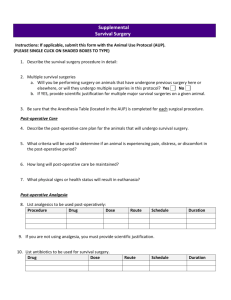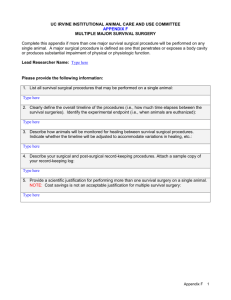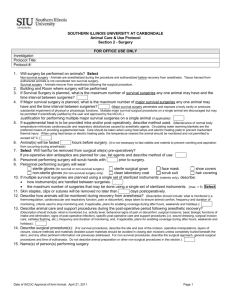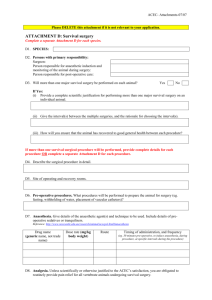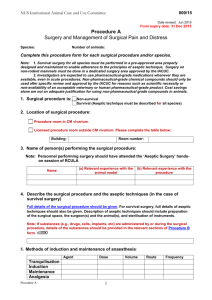APPENDUM 2 - ANIMAL SURGERY INFORMATION
advertisement
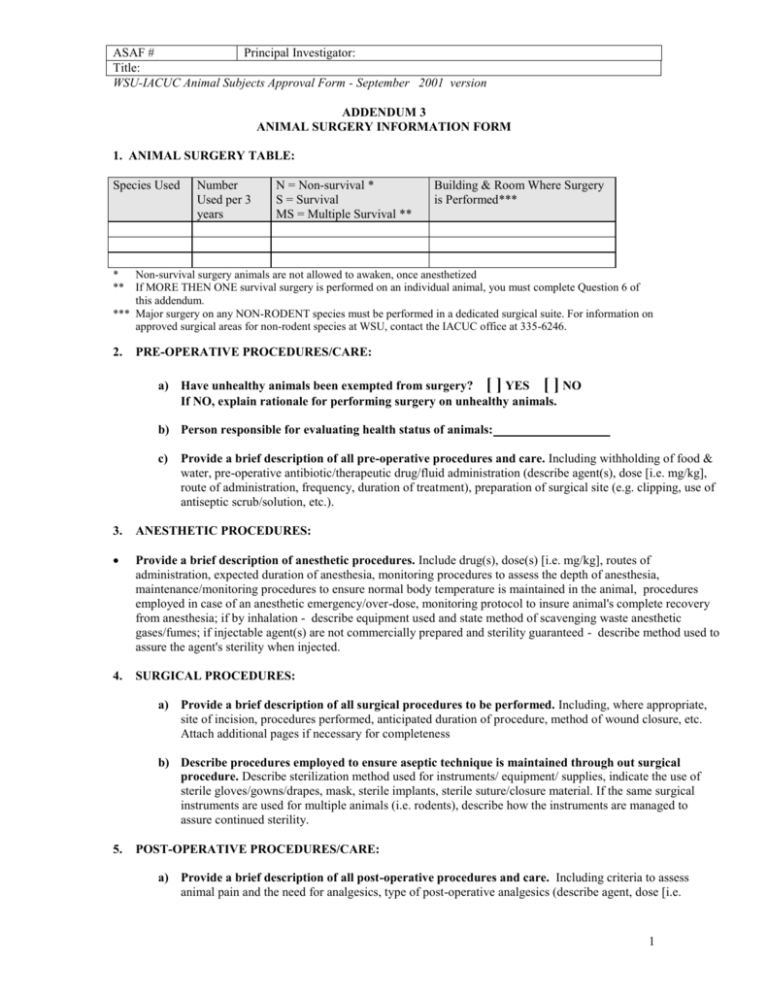
ASAF # Principal Investigator: Title: WSU-IACUC Animal Subjects Approval Form - September 2001 version ADDENDUM 3 ANIMAL SURGERY INFORMATION FORM 1. ANIMAL SURGERY TABLE: Species Used Number Used per 3 years N = Non-survival * S = Survival MS = Multiple Survival ** Building & Room Where Surgery is Performed*** * ** Non-survival surgery animals are not allowed to awaken, once anesthetized If MORE THEN ONE survival surgery is performed on an individual animal, you must complete Question 6 of this addendum. *** Major surgery on any NON-RODENT species must be performed in a dedicated surgical suite. For information on approved surgical areas for non-rodent species at WSU, contact the IACUC office at 335-6246. 2. PRE-OPERATIVE PROCEDURES/CARE: a) Have unhealthy animals been exempted from surgery? [ ] YES [ ] NO If NO, explain rationale for performing surgery on unhealthy animals. b) Person responsible for evaluating health status of animals: c) Provide a brief description of all pre-operative procedures and care. Including withholding of food & water, pre-operative antibiotic/therapeutic drug/fluid administration (describe agent(s), dose [i.e. mg/kg], route of administration, frequency, duration of treatment), preparation of surgical site (e.g. clipping, use of antiseptic scrub/solution, etc.). 3. ANESTHETIC PROCEDURES: Provide a brief description of anesthetic procedures. Include drug(s), dose(s) [i.e. mg/kg], routes of administration, expected duration of anesthesia, monitoring procedures to assess the depth of anesthesia, maintenance/monitoring procedures to ensure normal body temperature is maintained in the animal, procedures employed in case of an anesthetic emergency/over-dose, monitoring protocol to insure animal's complete recovery from anesthesia; if by inhalation - describe equipment used and state method of scavenging waste anesthetic gases/fumes; if injectable agent(s) are not commercially prepared and sterility guaranteed - describe method used to assure the agent's sterility when injected. 4. SURGICAL PROCEDURES: a) Provide a brief description of all surgical procedures to be performed. Including, where appropriate, site of incision, procedures performed, anticipated duration of procedure, method of wound closure, etc. Attach additional pages if necessary for completeness b) Describe procedures employed to ensure aseptic technique is maintained through out surgical procedure. Describe sterilization method used for instruments/ equipment/ supplies, indicate the use of sterile gloves/gowns/drapes, mask, sterile implants, sterile suture/closure material. If the same surgical instruments are used for multiple animals (i.e. rodents), describe how the instruments are managed to assure continued sterility. 5. POST-OPERATIVE PROCEDURES/CARE: a) Provide a brief description of all post-operative procedures and care. Including criteria to assess animal pain and the need for analgesics, type of post-operative analgesics (describe agent, dose [i.e. 1 mg/kg], route of administration, frequency, duration of treatment); techniques used to ensure maintenance of normal body temperature in the animal; incision care, monitoring and time of suture removal; catheter or long term care of any chronically instrumented/implanted animals, monitoring and time of removal; bandage/dressing monitoring and changing schedule. b) If post- operative analgesics will not be used, PROVIDE SCIENTIFIC JUSTIFICATION. c) Describe arrangements for post operative monitoring of animals, individual(s) responsible for performance of monitoring, including after-hour, weekend and holiday care. d) Describe the use of any antibiotics or other therapeutic drugs. Describe agent, dose [i.e. mg/kg], route of administration, frequency, duration of treatment. e) 6. If this surgical procedure induces a disease or other functional alteration, describe any anticipated adverse effects and deficiencies, monitoring protocol/schedule for animals, animals' degree of tolerance to disease/functional deficit. MULTIPLE SURGERIES: a) Will an individual animal be subjected to more than one (1) survival surgery? [ ] YES [ ] NO If YES, Complete 6b - 6e. b) Are the survival surgeries minor or major? (Minor survival surgery does not expose a body cavity and causes little or no physical impairment. Major surgery is defined as any surgical intervention that penetrates and exposes a body cavity OR which produces substantial impairment of physical or physiological functions.) c). Describe the number of operative procedures to be performed on a given animal, the frequency of such procedures, and the period of time between each major operative procedure. d) Provide a SCIENTIFIC JUSTIFICATION as to why animals must be subjected to multiple survival surgeries and how the surgeries are related. e) Describe measures to be taken to ensure that pain/distress are minimized. This addendum is to be included with your WSU-IACUC Animal Subjects Approval form or Amendment 2

